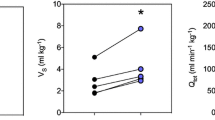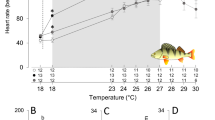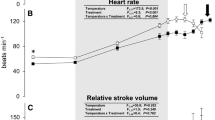Abstract
The venous haemodynamic response to enforced exercise and acute temperature increase was examined in the Antarctic fish Pagothenia borchgrevinki (borch) to enable comparisons with the existing literature for temperate species, and investigate if the unusual cardiovascular response to temperature changes previously observed in the borch can be linked to an inability to regulate the venous vasculature. Routine central venous blood pressure (P cv) was 0.08 kPa and the mean circulatory filling pressure (P mcf; an index of venous capacitance) was 0.14 kPa. Acute warming from 0 to 2.5 and 5°C increased heart rate (f H), while dorsal aortic blood pressure (P da) decreased. P mcf did not change, while P cv decreased significantly at 5°C. This contrasts with the venoconstriction previously observed in rainbow trout in response to increased temperature. Exercise resulted in small increases in P mcf and P cv, a response that was abolished by α-adrenoceptor blockade. This study demonstrates that the heart of P. borchgrevinki normally operates at positive filling pressures (i.e. P cv) and that venous capacitance can be actively regulated by an α-adrenergic mechanism. The lack of decrease in venous capacitance during warming may suggest that a small increase in venous tone is offset by a passive temperature-mediated increase in compliance.


Similar content being viewed by others
Explore related subjects
Discover the latest articles and news from researchers in related subjects, suggested using machine learning.References
Agnisola C, Acierno R, Calvo J, Farina F, Tota B (1997) In vitro cardiac performance in the sub-antarctic notothenioids Eleginops maclovinus (subfamily eleginopinae), Paranotothenia magellanica, and Patagonotothen tessellata (subfamily nototheniinae). Comp Biochem Physiol A 118:1437–1445
Altimiras J, Axelsson M (2004) Intrinsic autoregulation of cardiac output in rainbow trout (Oncorhynchus mykiss) at different heart rates. J Exp Biol 207:195–201
Axelsson M (2005) The circulatory system and its control. In: Farrell AP, Steffensen JF (eds) The physiology of polar fishes, vol 22. Academic Press, Dublin, pp 239–280
Axelsson M, Davison W, Forster ME, Farrell AP (1992) Cardiovascular responses of the red-blooded antarctic fishes Pagothenia bernacchii and P. borchgrevinki. J Exp Biol 167:179–201
Axelsson M, Davison B, Forster M, Nilsson S (1994) Blood pressure control in the antarctic fish Pagothenia borchgrevinki. J Exp Biol 190:265–279
Brett JR (1971) Energetic responses of salmon to temperature. A study of some thermal relations in the physiology and freshwater ecology of sockeye salmon (Oncorhynchus nerka). Am Zool 11:99–113
Brodeur JC, Dixon DG, McKinley RS (2001) Assessment of cardiac output as a predictor of metabolic rate in rainbow trout. J Fish Biol 58:439–452
Crawshaw LI (1976) Effect of rapid temperature change on mean body temperature and gill ventilation in carp. Am J Physiol 231:837–841
Davison W, Franklin CE (2003) Hypertension in Pagothenia borchgrevinki caused by X-cell disease. J Fish Biol 63:129–136
De Vries AL, Steffensen JF (2005) The Arctic and Antarctic polar marine environments. In: Farrell AP, Steffensen JF (eds) The physiology of polar fishes, vol 22. Academic Press, Dublin, pp 1–24
Farrell AP (1984) A review of cardiac performance in the teleost heart: intrinsic and humoral regulation. Can J Zool 62:523–536
Farrell AP (1997) Effects of temperature on cardiovascular performance. In: Wood CM, McDonald DG (eds) Global warming: implications for freshwater and marine fish. Cambridge University Press, Cambridge, pp 135–158
Farrell AP, Jones DR (1992) The heart. In: Hoar WS, Randal DJ, Farrell AP (eds) Fish physiology, the cardiovascular system, vol XII. Academic Press, Dublin, pp 1–88
Franklin CE, Davison W (1988) X-cells in the gills of an Antarctic teleost, Pagothenia borchgrevinki. J Fish Biol 32:341–353
Franklin CE, Davison W, Mckenzie JC (1993) The role of the spleen during exercise in the Antarctic teleost, Pagothenia borchgrevinki. J Exp Biol 174:381–386
Franklin CE, Davison W, Seebacher F (2007) Antarctic fish can compensate for rising temperatures: thermal acclimation of cardiac performance in Pagothenia borchgrevinki. J Exp Biol 210:3068–3074
Gollock MJ, Currie S, Petersen LH, Gamperl AK (2006) Cardiovascular and haematological responses of Atlantic cod (Gadus morhua) to acute temperature increase. J Exp Biol 209:2961–2970
Green JF, Jackman AP (1979) Mechanism of the increased vascular capacity produced by mild perfusion hypothermia in the dog. Circ Res 44:411–419
Hunt BM, Hoefling K, Cheng CHC (2003) Annual warming episodes in seawater temperatures in McMurdo Sound in relationship to endogenous ice in notothenioid fish. Antarct Sci 15:333–338
Korsmeyer KE, Lai NC, Shadwick RE, Graham JB (1997) Heart rate and stroke volume contributions to cardiac output in swimming yellowfin tuna: response to exercise and temperature. J Exp Biol 20:1975–1986
Lannig G, Bock C, Sartoris FJ, Pörtner HO (2004) Oxygen limitation of thermal tolerance in cod, Gadus morhua L., studied by magnetic resonance imaging and on-line venous oxygen monitoring. Am J Physiol 287:R902–910
Lowe CJ, Davison W (2005) Plasma osmolarity, glucose concentration and erythrocyte responses of two Antarctic nototheniid fishes to acute and chronic thermal change. J Fish Biol 67:752–766
Mark FC, Bock C, Pörtner HO (2002) Oxygen-limited thermal tolerance in Antarctic fish investigated by MRI and (31) P-MRS. Am J Physiol 283:R1254–1262
Mendonca PC, Genge AG, Deitch EJ, Gamperl AK (2007) Mechanisms responsible for the enhanced pumping capacity of the in situ winter flounder heart (Pseudopleuronectes americanus). Am J Physiol 293:R2112–R2119
Minerick AR, Chang HC, Hoagland TM, Olson KR (2003) Dynamic synchronization analysis of venous pressure-driven cardiac output in rainbow trout. Am J Physiol 285:R889–R896
Nilsson S, Forster ME, Davison W, Axelsson M (1996) Nervous control of the spleen in the red-blooded Antarctic fish, Pagothenia borchgrevinki. Am J Physiol 270:R599–R604
Pang CC (2001) Autonomic control of the venous system in health and disease: effects of drugs. Pharmacol Ther 90:179–230
Pörtner HO (2002) Climate variations and the physiological basis of temperature dependent biogeography: systemic to molecular hierarchy of thermal tolerance in animals. Comp Biochem Physiol A 132:739–761
Pörtner HO, Knust R (2007) Climate change affects marine fishes through the oxygen limitation of thermal tolerance. Science 315:95–97
Reynolds WW (1977) Thermal equilibration rates in relation to heartbeat and ventilatory frequencies in largemouth blackbass, Micropterus salmoides. Comp Biochem Physiol A 56:195–201
Rothe CF (1983) Reflex control of veins and vascular capacitance. Physiol Rev 63:1281–1342
Rothe CF (1993) Mean circulatory filling pressure: its meaning and measurement. J Appl Physiol 74:499–509
Rubini A (2005) Effect of perfusate temperature on pulmonary vascular resistance and compliance by arterial and venous occlusion in the rat. Eur J Appl Physiol 93:435–439
Sandblom E, Axelsson M (2005) Baroreflex mediated control of heart rate and vascular capacitance in trout. J Exp Biol 208:821–829
Sandblom E, Axelsson M (2007a) The venous circulation: a piscine perspective. Comp Biochem Physiol A 148:785–801
Sandblom E, Axelsson M (2007b) Venous hemodynamic responses to acute temperature increase in the rainbow trout (Oncorhynchus mykiss). Am J Physiol 292:R2292–R2298
Sandblom E, Farrell AP, Altimiras J, Axelsson M, Claireaux G (2005) Cardiac preload and venous return in swimming sea bass (Dicentrarchus labrax L.). J Exp Biol 208:1927–1935
Sandblom E, Axelsson M, McKenzie DJ (2006a) Venous responses during exercise in rainbow trout, Oncorhynchus mykiss: α-adrenergic control and the antihypotensive function of the renin–angiotensin system. Comp Biochem Physiol A 144:401–409
Sandblom E, Axelsson M, Farrell AP (2006b) Central venous pressure and mean circulatory filling pressure in the dogfish Squalus acanthias: adrenergic control and role of the pericardium. Am J Physiol 291:R1465–R1473
Satchell GH (1991) Physiology and form of fish circulation. Cambridge University Press, Cambridge
Satchell GH (1992) The venous system. In: Hoar WS, Randall DJ, Farrell AP (eds) The cardiovascular system, part A, vol XII, pp 141–183
Shiels HA, Vornanen M, Farrell AP (2002) The force–frequency relationship in fish hearts—a review. Comp Biochem Physiol A 132:811–826
Shoukas AA, Brunner MC (1980) Epinephrine and the carotid sinus baroreceptor reflex. Influence on capacitive and resistive properties of the total systemic vascular bed of the dog. Circ Res 47:249–257
Stevens ED, Bennion GR, Randall DJ, Shelton G (1972) Factors affecting arterial pressure and blood flow from the heart in intact, unrestrained lingcod, Ophiodon elongatus. Comp Biochem Physiol 43A:681–695
Sundin L, Davison W, Forster M, Axelsson M (1998) A role of 5-HT2 receptors in the gill vasculature of the antarctic fish Pagothenia borchgrevinki. J Exp Biol 201:2129–2138
Sundin L, Axelsson M, Davison W, Forster ME (1999) Cardiovascular responses to adenosine in the antarctic fish Pagothenia borchgrevinki. J Exp Biol 202(Pt 17):2259–2267
Acknowledgments
The authors would like to thank Antarctica New Zealand and base staff of Scott Base for logistics support and the ability to visit and work in Antarctica. E.S. and M.A. were financially supported by travel and research grants from the Swedish Research Council.
Author information
Authors and Affiliations
Corresponding author
Additional information
Communicated by I.D. Hume.
Rights and permissions
About this article
Cite this article
Sandblom, E., Axelsson, M. & Davison, W. Enforced exercise, but not acute temperature elevation, decreases venous capacitance in the stenothermal Antarctic fish Pagothenia borchgrevinki . J Comp Physiol B 178, 845–851 (2008). https://doi.org/10.1007/s00360-008-0272-x
Received:
Revised:
Accepted:
Published:
Issue Date:
DOI: https://doi.org/10.1007/s00360-008-0272-x




